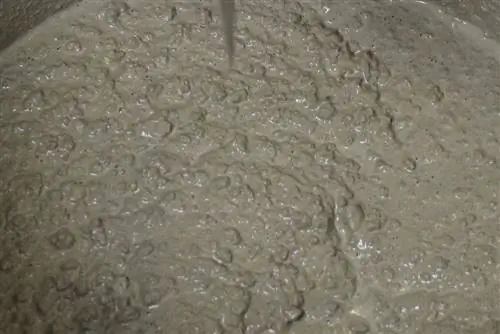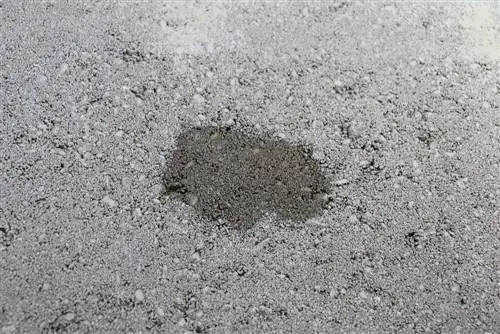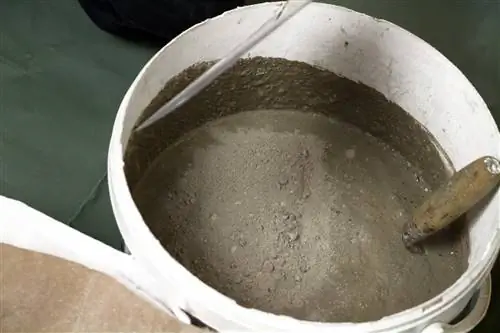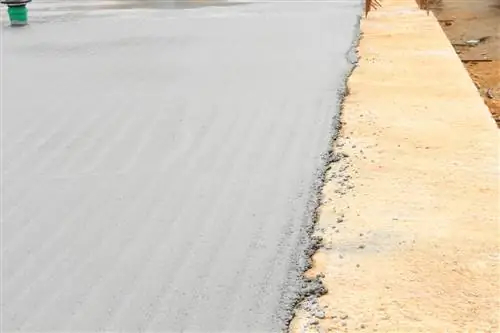- Author admin [email protected].
- Public 2023-12-17 03:39.
- Last modified 2025-06-01 06:48.
Mixing concrete yourself is not a challenge - as long as the correct mixing ratios are known. These in turn depend on what is to be concreted. Will the concrete later only be exposed to mechanical stress or will it also have to withstand frost and chemical influences? In order to achieve a robust result, the ratio of the individual components must be optimally coordinated.
Mixture
Concrete consists of three components: cement, water and the so-called aggregate. The aggregate is sand, gravel or grit. You can also add colors or pigments to this mixture and use them to color the concrete/cement.
The ratio between cement and aggregate is 1:4. So concrete consists of one part cement and four parts aggregate. Added to this is the water. However, how much water is added depends on the exposure class. This indicates how strong and what the concrete will be subjected to later. However, the amount of water can also be easily calculated.
Density and quantity
Concrete has an average density of 2.4 to 2.5 kg/dm³ (kilograms per cubic decimeter). For a volume of one cubic meter, 2,400 to 2,500 kg of concrete are required. From this you can easily calculate the amount of cement required.
Concrete consists of one part cement and four parts aggregate or one fifth cement. The total amount of concrete required is simply divided by five to get the required amount of cement. For one cubic meter this means:
- 2400 kg / 5=480 kg
- 2500 kg / 5=500 kg
For onecubic meter of concrete,480 to 500 kg of cement are required.
Of course, the calculation can also be carried out in the other direction to calculate how much concrete can be made from the existing cement. To do this, the amount of cement is simply multiplied by five. This results in a standard packaging size of 25 kg of cement:
25 kg cement x 5=125 kg concrete
W/C value

The W/C value indicates how much water must be added to the cement and the aggregate in order to obtain the most resistant result possible. The value depends on what stresses and environmental influences the concrete will later have to withstand. The W/C value is in the following cases:
Mechanical wear
- Very strong 0, 40
- Strong 0, 45
- Medium 0.55
Frost
- At high water saturation 0, 50
- At moderate water saturation 0, 60
Chemical influences
- Weak 0, 60
- Medium 0, 50
- Strong 0, 45
Calculate ratios
In order to calculate the need for cement, aggregate and water, the total amount required in kilograms must first be calculated. To do this, the volume is first calculated by multiplying the length, width and height together. For example, if a path one meter wide and ten meters long is to be covered with a ten centimeter thick layer of concrete, the concrete volume required is:
- 1 meter (width) x 10 meters (length)=10 square meters
- 10 square meters x 0.1 meter (height or thickness of the concrete layer)=1 cubic meter
Due to the average mass of 2,450 kg of concrete per cubic meter, 2,400 to 2,500 kg of concrete are required. This in turn results in a need for cement of:
2,500 kg concrete / 5=500 kg cement (20 bags of 25 kg each)
For the surcharge, the total amount of concrete is multiplied by 4/5 or 0.8 or the difference between the total amount and concrete is used.
- 2,500 kg concrete x 0.8=2,000 kg surcharge
- 2,500 kg concrete - 500 kg cement=2,000 kg surcharge
Finally, the required amount of water is calculated using the W/C value. For example, if the concrete is exposed to strong mechanical wear, the W/C value is 0.40. The ratio of cement and water is calculated by simple multiplication:
500 kg cement x 0.40 W/C value=200 liters of water
For the example given with a quantity of 2,500 kilograms of concrete, 500 kg of cement, 2,000 kg of aggregate and 200 liters of water are required.
Costs
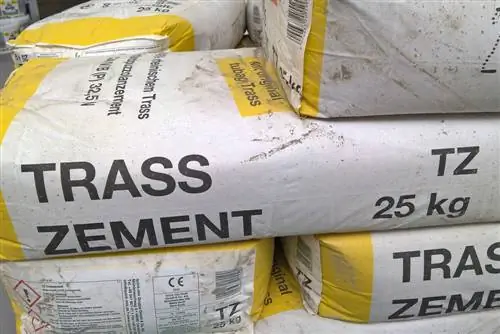
For a standard packaging size of 25 kg of cement, you should expect costs of 3 to 6 euros. For the example above, 500 kg of cement is required. The costs for this are calculated as follows:
- 500 kg total quantity / 25 kg bag=20 bags of cement
- 3 euros per bag x 20 bags=60 euros
- 6 euros per bag x 20 bags=120 euros
The average costs can be between60 and 120 euros.
In addition, there are the costs for the respective surcharge. Depending on the size, you can expect 30 to 50 euros per ton for concrete gravel, chippings and sand, which results in a price of 60 to 100 euros for the calculation example.
The raw materials should therefore cost120 to 220 euros
It should be noted that the delivery is often higher than the price of cement and surcharge due to the high weight. This information is therefore not the total price.

